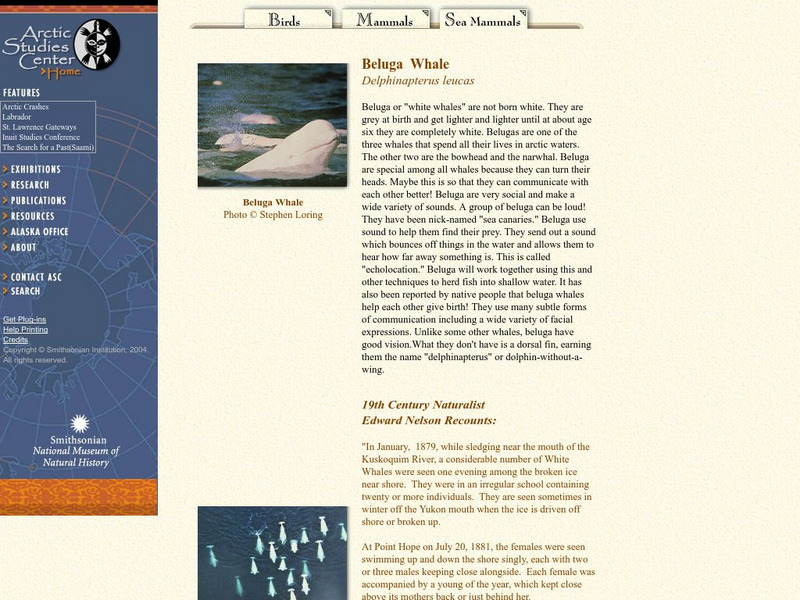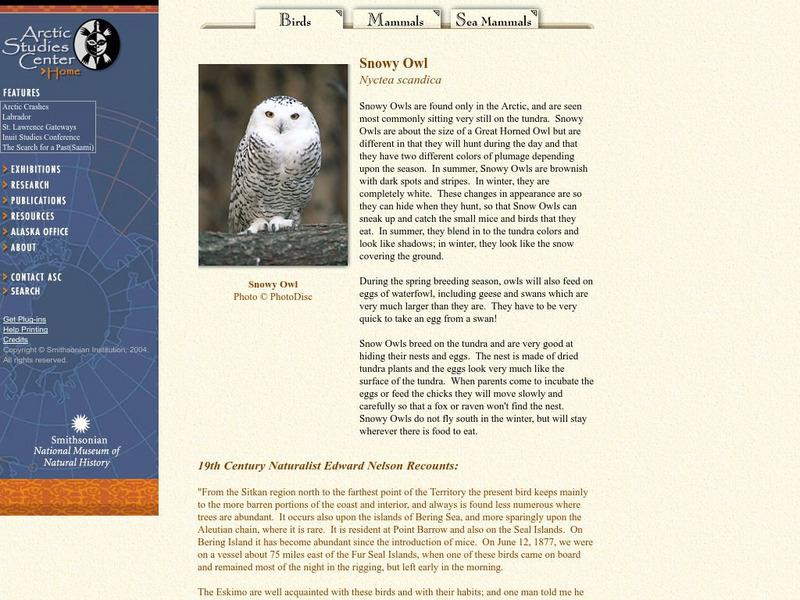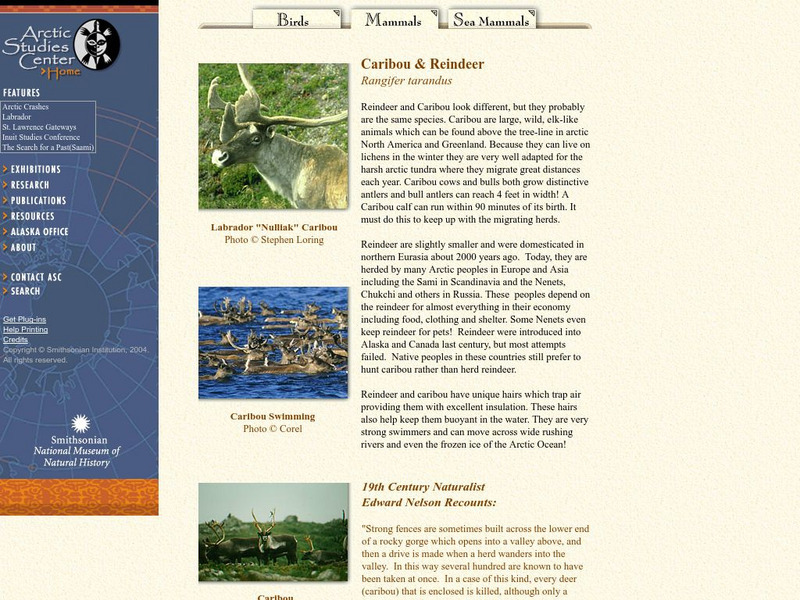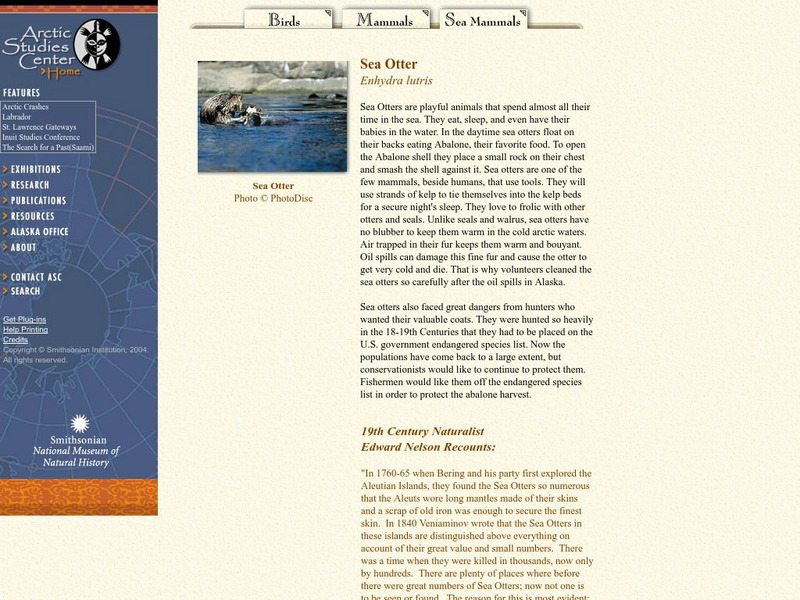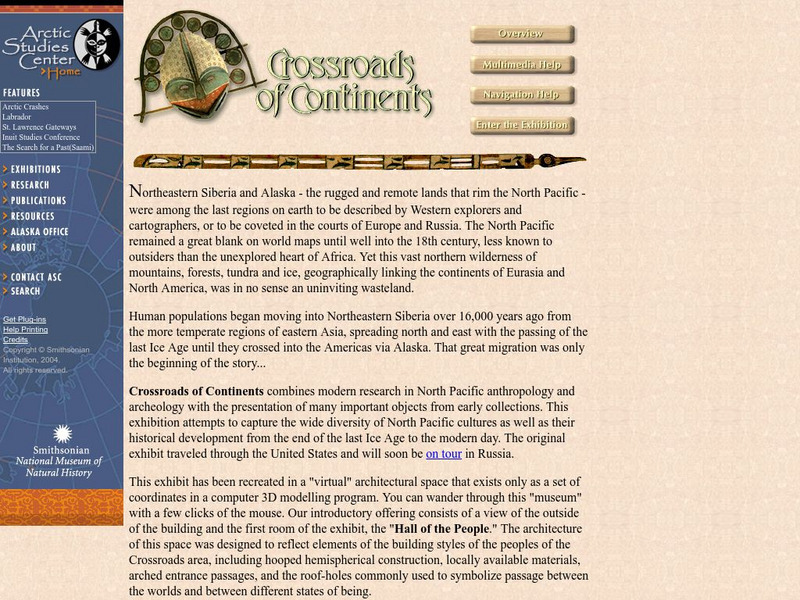Smithsonian Institution
National Museum of Natural History: African Voices
This site is the web presence of "African Voices," a permanent exhibition at the National Museum of Natural History. It explores the "diversity, dynamism, and global influence of Africa's peoples and cultures." Includes art, texts, and...
Smithsonian Institution
National Museum of Natural History: Beluga Whale
This site provides a general overview of the Beluga Whale, complete with the personal observations of 19th Century Naturalist, Edward Nelson.
Smithsonian Institution
National Museum of Natural History: Snowy Owl
This Smithsonian website has a brief, but thorough, article on the Snowy Owl that also includes a picture and an extensive quote from the 19th Century naturalist Edward Nelson.
Smithsonian Institution
National Museum of Natural History: Tufted Puffin
This Smithsonian website has a brief, but thorough, article on the Tufted Puffin. It also includes pictures and an extensive quote from 19th Century naturalist Edward Nelson.
Smithsonian Institution
National Museum of Natural History: Arctic Studies Center:caribou & Reindeer
This site takes a look at the caribou and reindeer found in arctic regions around the world. Content includes the personal observations of the 19th Century Naturalist, Edward Nelson.
Smithsonian Institution
National Museum of Natural History: Arctic Studies Center Mammals Sea Otter
This Smithsonian website has a brief, but thorough, article on the Sea Otters that also includes a picture and an extensive quote from naturalist Edward Nelson.
Smithsonian Institution
National Museum of Natural History: Muskox
This site takes a very brief look at the muskox as an arctic creature. Several photographs are also provided.
Smithsonian Institution
National Museum of Natural History: The Living Yamal
A Smithsonian site that tells of the history and culture of the Yamal people of Siberia.
Smithsonian Institution
National Museum of Natural History: American Mammals: Hooded Skunk
The Smithsonian National Museum of Natural History, in a section titled "North American Mammals," offers a general overview of the hooded skunk. Content includes detailed drawings, photographs, specimens, and a map showing the skunk's...
Smithsonian Institution
National Museum of Natural History: Crossroads of Continents
Very interesting Smithsonian web exhibition on the culture of the peoples surrounding the Bering Strait. Enter the museum to find lost cultures due to the Cold War. Fun museum to click around in!
Smithsonian Institution
National Museum of Natural History: Search the Giant Squid
This site explores, in detail, what is known about the Giant Squid, and current efforts to uncover the squid in its natural habitat.
Smithsonian Institution
National Museum of Natural History: Old Goats in Transition
Read about pre-historic animal domestication, something that that has been studied rigorously by scientists, but not yet fully understood. The bottom half of this article focuses on goat domestication as it was practiced in southwestern...
Smithsonian Institution
National Museum of Natural History: Human Characteristics: Tools & Foods
Learn about the history of how humans have used tools to meet their need for food, beginning with the ancient tools our ancestors used millions of years ago. Non-human primates also use some tools.
Smithsonian Institution
National Museum of Natural History: Arctic Studies Center: Aleut
The Arctic Studies Center at the Smithsonian provides general notes on the Aleut people of Alaska. Includes a picture of a painting of an Aleut Hunter.
Smithsonian Institution
National Museum of Natural History: Black and White Colobus
Brief overview of the black-and-white colobus monkey and accompanying photos demonstrate the physical adaptations that allow this animal to survive in its habitat.
Smithsonian Institution
National Museum of Natural History: Where Do Mammals Live: Lion
Illustrated overview of the lion explains how the different roles of males and females help lions survive in their habitat.
Smithsonian Institution
National Museum of Natural History: Hall of Mammals: Leopard Seal
Brief overview of the leopard seal and an accompanying photo demonstrate the physical adaptations that allow this animal to eat meat.
Smithsonian Institution
National Museum of Natural History: Hall of Mammals: Caribou
Brief overview of the caribou and an accompanying photo illustrate the physical adaptations that allow this animal to migrate to find its food supply.
Smithsonian Institution
National Museum of Natural History: Hall of Mammals: Prairie Dog
Brief illustrated overview of the prairie dog and an accompanying video demonstrate the physical adaptations that allow this animal to survive in its habitat.
Smithsonian Institution
National Museum of Natural History: Hall of Mammals: Jaguar
Brief overview of the jaguar and accompanying photos demonstrate the physical adaptations that allow this animal to hunt for its prey.
Smithsonian Institution
National Museum of Natural History: Hall of Mammals: Pygmy Marmoset
A brief overview of the pygmy marmoset and accompanying photos demonstrate the physical adaptations that allow this animal to eat.
Smithsonian Institution
National Museum of Natural History: Giant Squid Resurfaces
The National Museum of Natural History?s giant squid exhibit has reopened, and this website explores some of the more recent discoveries on this very elusive yet very intriguing animal.
Smithsonian Institution
National Museum of Natural History: Our Way of Making Prayer
The native Yup'ik people of Alaska, like many other Native American tribes, once used decorative masks for ceremonial purposes. Here you can read a short introductory piece about the masks, view the masks, and watch several short video...
Smithsonian Institution
National Museum of Natural History: Where Do Mammals Live: Giraffe
Review basic facts about the giraffe and launch an interactive activity that demonstrates the length of its tongue, a physical adaptation that helps the giraffe survive in its environment.



